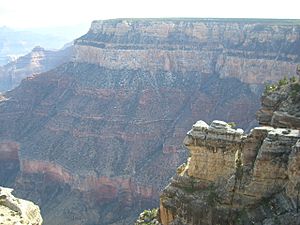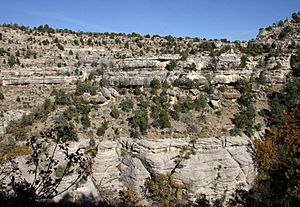Kaibab Limestone facts for kids
Quick facts for kids Kaibab LimestoneStratigraphic range: Early to Middle Permian, Leonardian to Roadian |
|
|---|---|

The Kaibab Limestone forms layers and cliffs at the Grand Canyon.
|
|
| Type | Geological formation |
| Sub-units | Fossil Mountain and Harrisburg members |
| Underlies | Moenkopi Formation |
| Overlies | Toroweap Formation, Coconino Sandstone, and White Rim Sandstone |
| Thickness | 300 feet (91 m)-500 feet (150 m) in Grand Canyon region. |
| Lithology | |
| Primary | limestone with fossils, sandy limestone, dolomite, and chert |
| Other | gypsum, siltstone, and sandstone |
| Location | |
| Region | Arizona-(northern) California-(southeast) Nevada-(east-central) and, Utah-(southern) |
| Country | United States- (Southwestern United States) |
| Type section | |
| Named for | It was named for the Kaibab Plateau, northern Arizona |
| Named by | Darton (1910) |
The Kaibab Limestone is a strong rock layer that forms tall cliffs. It was created during the Permian Period. You can find it in northern Arizona, southern Utah, eastern Nevada, and southeastern California. It's also called the Kaibab Formation in some areas. This rock layer forms the very top edge, or rim, of the famous Grand Canyon. In California, it's sometimes called the Kaibab Marble because it has changed a lot due to heat and pressure.
Contents
What's in the Kaibab Limestone?
The Kaibab Limestone is made of different kinds of sedimentary rocks. These are rocks formed from layers of sand, mud, and tiny bits of shells. It has layers of carbonate rocks (like limestone) and siliciclastic rocks (like sandstone). Over time, some of the limestone changed into dolomite. Also, some limestone turned into chert, which is a very hard, glassy rock.
In the western part of the Grand Canyon, a section called the Fossil Mountain Member has lots of fossils. These fossils are from sea creatures that lived in the ocean long ago. Further east, this section changes. It becomes more like sandy dolomite and has fewer types of fossils.
The Harrisburg Member is the top part of the Kaibab Limestone. It forms the highest cliffs and ledges at the Grand Canyon. This part is made of gypsum, dolomite, sandstone, and redbeds.
Where Does it Sit?
The Kaibab Limestone sits on top of other rock layers. In the Grand Canyon, it lies above the Toroweap Formation. Scientists used to think there was a big gap in time between these two layers. But now they believe the layers are mostly continuous. Any breaks are likely from where underground salt deposits dissolved, causing the rocks above to collapse.
South and east of the Grand Canyon, the Kaibab Limestone sits directly on top of the Coconino Sandstone. In parts of Utah and Arizona, it lies on the White Rim Sandstone.
The top of the Kaibab Limestone has a clear break with the rock layer above it, called the Moenkopi Formation. This break means there was a long period of time when no new rocks were laid down. Instead, the Kaibab Limestone was worn away by wind and water. In some places, ancient river valleys and caves were carved into the Kaibab Limestone before the Moenkopi Formation was deposited. These valleys are often filled with conglomerates (rocks made of pebbles and larger pieces).
Even though the Moenkopi Formation was once on top, much of it has been worn away. This is because the Moenkopi rocks are softer than the Kaibab Limestone. That's why the Kaibab Limestone forms the flat tops of many large plateaus around the Grand Canyon.
Amazing Fossils!
The Kaibab Limestone is full of amazing fossils from the Permian Period. These include both invertebrates (animals without backbones) and vertebrates (animals with backbones).
You can find fossils of:
- brachiopods (shellfish)
- corals
- crinoids (sea lilies)
- echinoid spines (from sea urchins)
- mollusks (like snails and clams)
- sponges
- trilobites (ancient sea bugs)
- Burrows made by ancient shrimp
Scientists have also found huge, football-sized nautiloids (a type of cephalopod) and many different kinds of shark teeth in the Kaibab Limestone of Arizona.
How the Kaibab Limestone Formed
The different types of rocks in the Kaibab Limestone show that they were laid down in a shallow sea. This sea had a gently sloping bottom. The sea level changed often during this time. Even small changes in sea level caused the coastline to move a lot. This created a mix of different types of sediments and rocks.
This gently sloping area stretched from northern Arizona all the way to southern Nevada, sometimes being over 200 miles wide! Scientists think the sea level changes were caused by glaciers melting and growing, which made the ocean levels go up and down.
How Old is It?
Scientists have studied the fossils in the Kaibab Limestone to figure out its age. Based on the fossils of brachiopods and sponges, they know it formed during the Leonardian Age. This is part of the Early Permian Period. More recent studies of tiny fossils called conodonts show that some parts of the Kaibab Limestone are even younger, extending into the Roadian Age, which is the very end of the Early Permian and beginning of the Middle Permian.
Where Can You See It?
The Kaibab Limestone is found in many places across the southwestern United States. You can see it in:
- Capitol Reef National Park
- Grand Canyon
- Zion National Park
- Grand Staircase–Escalante National Monument
It's also found in other areas like the Blue Diamond Mine in Nevada.
Images for kids





